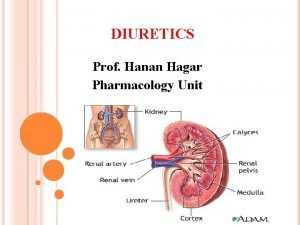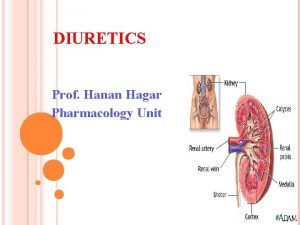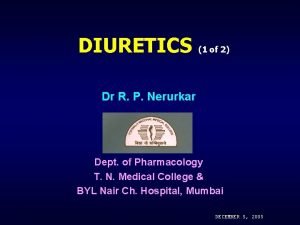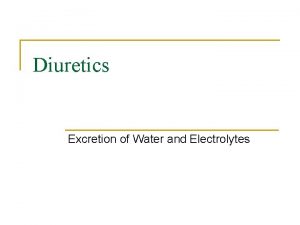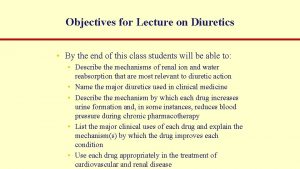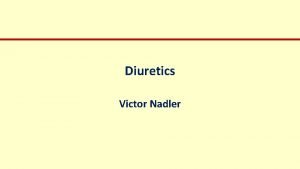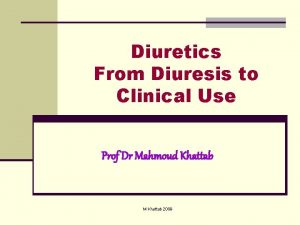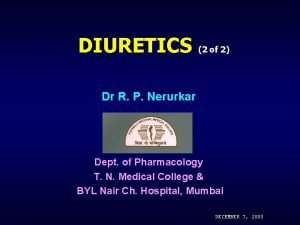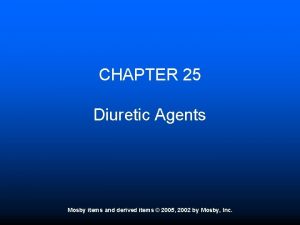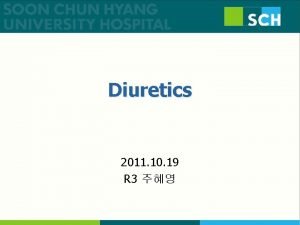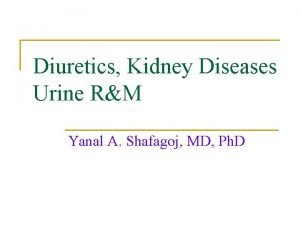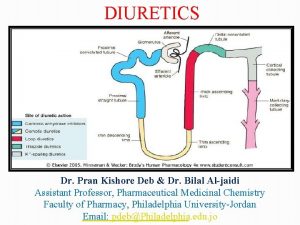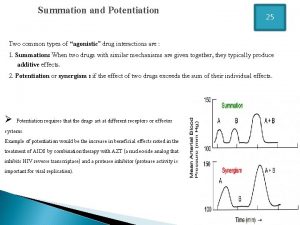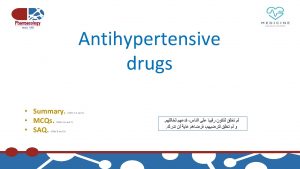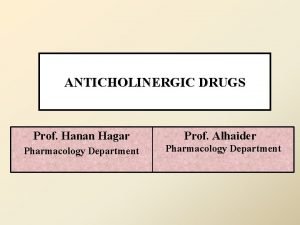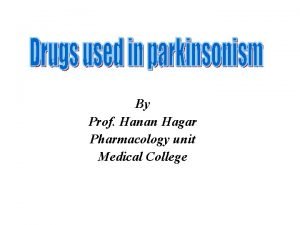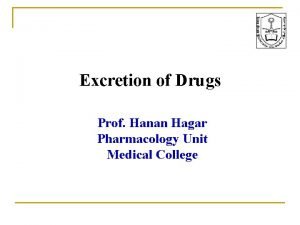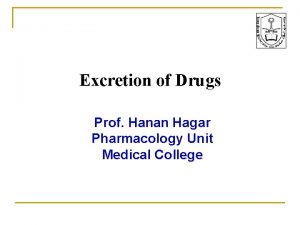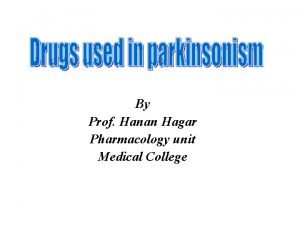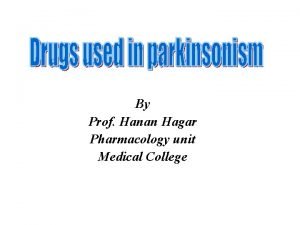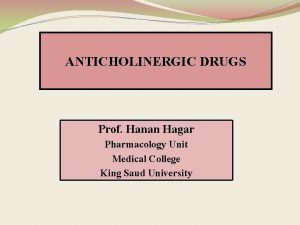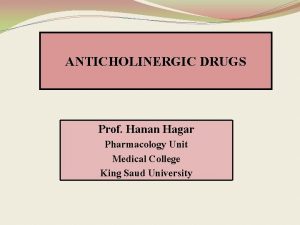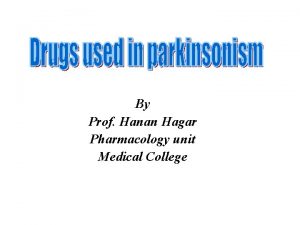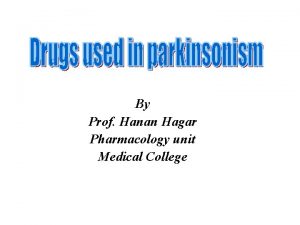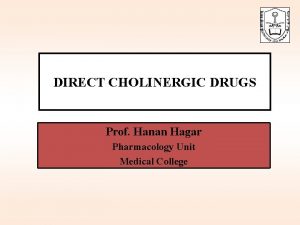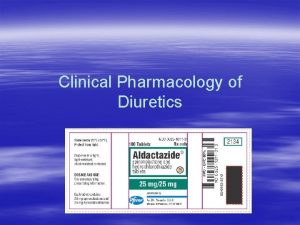DIURETICS Prof Hanan Hagar Pharmacology Unit CLASSIFICATION OF






























- Slides: 30

DIURETICS Prof. Hanan Hagar Pharmacology Unit

CLASSIFICATION OF DIURETICS Carbonic Anhydrase Inhibitors Loop Diuretics Thiazides Potassium-Sparing Diuretics Osmotic Diuretics

Loop Diuretics

LOOP DIURETICS HIGH CEILING DIURETICS The most potent diuretic, termed “high ceiling diuretic” Efficacy: High natriuresis as 25 -30% Na+ is reabsorbed. Drugs as: Furosemide - Torsemide Bumetanide – Ethacrynic acid

LOOP DIURETICS HIGH CEILING DIURETICS Bumetanide Potency 40 , t½ 0. 8 h Furosemide Potency 1, t½ 1. 5 h Ethacrynic Acid Potency 0. 7, t½ 1 h Torsemide Potency 3, t½ 3. 5 h

LOOP DIURETICS Mechanism: inhibit Na+ / K+ / 2 Cl- co-transporter in the luminal membrane of the thick ascending loop of Henle (TAL). inhibit Ca++ and Mg ++ re-absorption.

Ascending loop of Henle Is impermeable to water In thick ascending loop of Henle (TAL) is responsible for active re-absorption of Na, K and Cl (25 -30% Na+ is reabsorbed) via transport system in luminal membrane called Na+/ K+ / 2 Cl- co-transporter Ca and Mg are reabsorbed and enter the interstitial fluid via paracellular pathway

Ascending loop of Henle

ASCENDING LOOP OF HENLE

PHARMACOKINETICS Given orally or I. V. Have fast onset of action (suitable for emergency) Have short duration of action. Excreted by active tubular secretion of weak acids into urine Interfere with uric acid secretion (hyperuricemia).

PHARMACOLOGICAL EFFECTS: ↑ urinary excretion of Na+ and K+ ↑ urinary excretion Ca++ and Mg ++ ↑ urine volume ↑ renal blood flow.

Uses: are drug of choice for emergency situations as: Edema associated with congestive heart failure, nephrotic syndrome Acute pulmonary edema Acute hyperkalaemia. Acute hypercalcemia

ADVERSE EFFECTS Volume Depletion Hypokalemia Hypocalcaemia Hypomagnesaemia Metabolic Alkalosis Ototoxicity Hyperuricemia Hyperglycemia

Loop diuretics Drug- drug interactions NSAIDS Digitalis Aminoglycosides ↓Diuretic Response Arrhythmias ↑ Ototoxicity of Loop Diuretic

ADVERSE EFFECTS : Hypovolemia Hyponatraemia Hypokalemia (↓ blood Na+). (↓ blood K+) Hypomagnesaemia Hypocalcaemia Metabolic Postural Dietary (↓ blood Mg 2+) (↓ blood Ca 2+) alkalosis. hypotension K supplementation or K-sparing diuretics should be used to avoid hypokalemia.

ADVERSE EFFECTS : Hyperuricemia (increase blood uric acid and gouty attack). Ototoxicity (risk increased if combined with aminoglycosides) Allergic reactions

THIAZIDE DIURETICS Drugs as: Chlorothiazide Hydrochlorothiazide Chlorthalidone Metolazone Indapamide

THIAZIDE DIURETICS Chlorthalidone Chlorothiazide Potency 10, t½ 26 h Potency 0. 1, t½ 2 h Metolazone Potency 5, t½ 5 h Hydrochlorothiazide Potency 1 , t½ 3 h Indapamide Potency 20, t½ 16 h

THIAZIDE DIURETICS Mechanism of action: acts via inhibition of Na/Cl cotransporter on the luminal membrane of distal convoluted tubules. Efficacy: Moderate natriuresis (5 -10% of filtered load of sodium is reabsorbed).

Distal convoluted tubules

MECHANISM OF ACTION OF THIAZIDE DIURETICS

Pharmacokinetics: Given orally, slow of onset long duration of action (40 h) are secreted by active tubular secretory system of the kidney may interfere with uric acid secretion and cause hyperuricemia

PHARMACOLOGICAL EFFECTS: urinary Na. Cl excretion urinary K excretion (Hypokalemia) urinary magnesium excretion urinary calcium excretion calcium re-absorption hypercalcemia

THIAZIDE DIURETICS

USES: Treatment of essential hypertension (cheapwell tolerated). Treatment of mild heart failure (to reduce extracellular volume). Treatment of osteoporosis

USES: Calcium nephrolithiasis due to hypercalciuria (to increase calcium re-absorption and decrease renal calcium stones) Nephrogenic diabetes insipidus (decrease blood volume and GFR)

Mechanism of antidiuretic effect of thiazide in diabetes insipidus Thiazide Urine volume Distal tubular Na+ reabsorption Distal delivery of Na+ & water Urinary excretion Proximal Na+ & Water reabsorption Extracellular volume

ADVERSE EFFECTS: Fluid and electrolyte imbalance Hyponatremia Hypovolemia (volume depletion) Hypokalemia Metabolic alkalosis. Hyperuricaemia (gout) Hypercalcemia Hyperglycaemia Hyperlipidemia

ADVERSE EFFECTS Metabolic Alkalosis Volume Depletion Hypokalemia Hyperuricemia Hypocalcaemia Hypomagnesaemia Hyperglycemia Hyperlipidemia

Thiazide diuretics Drug- drug interactions Uricosurics Sulphonylurea Thiazides Diminish effect Digitalis Diazoxide Thiazides Increase effect NSAIDs Reduce thiazide efficacy https: //www. youtube. com/watch? v=9 OBv. Npn. S 0 h 4
 Diuretics classification
Diuretics classification Diuretic classification
Diuretic classification Hyperuricemia classification
Hyperuricemia classification Diuretics classification
Diuretics classification Diuretics classification
Diuretics classification Diuretics classification
Diuretics classification Diuretics classification
Diuretics classification Shiva china
Shiva china Hagar hamed rua
Hagar hamed rua Factors affecting drug metabolism
Factors affecting drug metabolism Glucouronide
Glucouronide A tirinha de hagar estabelece uma interessante contraponto
A tirinha de hagar estabelece uma interessante contraponto Phillip hagar smith
Phillip hagar smith Stone angel summary
Stone angel summary Hanan lutfiyya
Hanan lutfiyya Tim vidas
Tim vidas Hanan habib
Hanan habib Tb meningitis
Tb meningitis Diuretics side effects
Diuretics side effects Loop diuretics adverse effects
Loop diuretics adverse effects Loop diuretics adverse effects
Loop diuretics adverse effects Acetazolamise
Acetazolamise Mannitol uses
Mannitol uses Potassium sparing diuretics mechanism of action
Potassium sparing diuretics mechanism of action Side effects of diuretics
Side effects of diuretics Loop diuretics
Loop diuretics Anti diuretics drugs name
Anti diuretics drugs name Urine r m
Urine r m Pran kishore
Pran kishore Isovue
Isovue Potentiation example
Potentiation example

